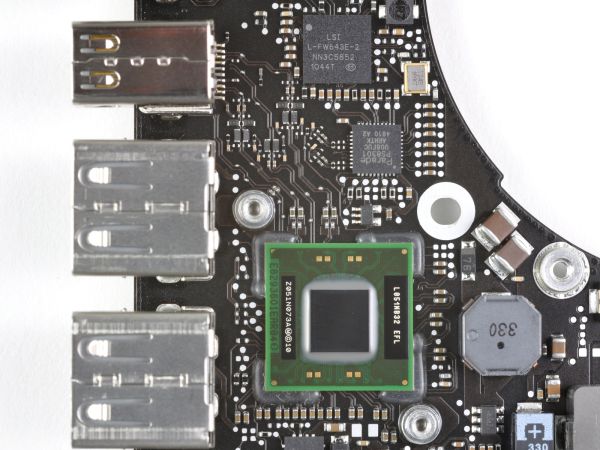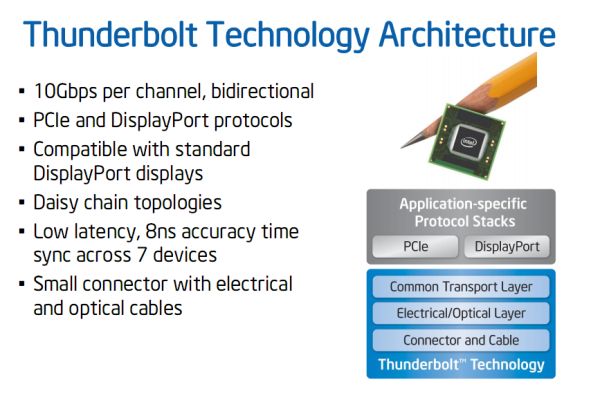Intel's Codename Light Peak Launches as Thunderbolt
by Brian Klug on February 25, 2011 1:10 AM EST- Posted in
- CPUs
- LightPeak
- News
- Thunderbolt
Back at IDF 2010, we wrote about Intel Light Peak nearing its eventual launch in 2011. Back then, the story was a 10 Gbps or faster physical link tunneling virtually every protocol under the sun over optical fiber. Though an optical physical layer provided the speed, in reality the connector and physical layer itself wasn’t as important as the tunneling and signaling going on beneath it. The dream was to provide a unified interface with enough bandwidth to satisfy virtually everything desktop users need at the same time - DVI, HDMI, DisplayPort, USB, FireWire, SATA, you name it. Daisy chain devices together, and connect everything with one unified connector and port. At IDF, we saw it moving data around between an Avid HD I/O box, a Western Digital external RAID array, and simultaneously outputting audio and video over HDMI. Intel also had another live demo working at over 6.5 Gbps.
That dream lives on today, but sans optical fiber and under a different name. Intel’s codename “Light Peak” is now named Thunderbolt. In addition, instead of optical fiber, ordinary copper does an adequate enough job until suitably cheap optical components are available. It’s a bit tough to swallow that optical fiber for the desktop still isn’t quite ready for mainstream consumption - issues like bend radius and the proper connectors were already mitigated - but copper is good enough in the meantime. Thunderbolt launched with the 2011 MacBook Pro, and though the interface isn’t Apple exclusive, will likely not see adoption in the PC space until 2012.
Although Thunderbolt in its launch instantiation is electrical, future versions will move to and support optical connections. When the transition to optical takes place, legacy electrical connector devices will work through cables with an electro-optical transceiver on the cable ends so there won’t be any need to use two separate kinds of cables. The optical version of Thunderbolt is allegedly coming later this year.
Thunderbolt shares the same connectors and cabling with mini DisplayPort, however Thunderbolt cables have different, tighter design requirements to fully support Thunderbolt signaling. DisplayPort is an interesting choice since it’s already one of the fastest (if not the fastest) desktop interfaces, topping out at 17.28 Gbps in DisplayPort 1.2 at lengths of under 3 meters. At longer distances, physics rears its ugly head, and throughput drops off over electrical links. Of course, the eventual advantages of moving to photons instead of electrons are greater distance without picking up much latency.
Thunderbolt is dual-channel, with each channel supporting 10 Gbps of bidirectional bandwidth. That’s a potential 20 Gbps of upstream and 20 Gbps of downstream bandwidth. The connection supports a daisy chain topology, and Thunderbolt also supports power over the cable, 10W to be precise. We aren't sure at this time what the breakdown on voltage/amperage is though.
Back when it was Light Peak, the goal was to tunnel every protocol under the sun over a common fast link. Multiplex everything together over one protocol-agnostic link, and then you could drop relevant data for each peripheral at each device in the daisy chain. Up to 2 high-resolution DisplayPort 1.1a displays and 7 total devices can be daisy chained. Thunderbolt instead carries just two protocols - DisplayPort and PCI Express. Tunnel a PCIe lane over the link, and you can dump it out on a peripheral and use a local SATA, FireWire, USB, or Gigabit ethernet controller to do the heavy lifting. Essentially any PCI Express controller can be combined with the Thunderbolt controller to act like an adapter. If you want video from the GPU, a separate dedicated DisplayPort link will work as well. Looking at the topology, a 4x PCI Express link is required in addition to a direct DisplayPort connection from the GPU.
Apple learned its lesson after FireWire licensing slowed adoption - the Thunderbolt port and controller specification are entirely Intel’s. Similarly, there’s no per-port licensing fee or royalty for peripheral manufacturers to use the port or the Thunderbolt controller. iFixit beat Anand and me to tearing down the 2011 MacBook Pro (though I did have one open, and was hastily cramming my OptiBay+SSD and HDD combo inside) and already got a shot of Intel's Thunderbolt controller, which itself is large enough to be unmistakable:
 Thunderbolt Controller IC on 15" 2011 MacBook Pro - Courtesy iFixit
Thunderbolt Controller IC on 15" 2011 MacBook Pro - Courtesy iFixit
In addition, you can still plug normal mini Display Port devices into Thunderbolt ports and just drive video if you so choose.
Though there aren’t any Thunderbolt compatible peripherals on the market right now, Western Digital, LaCie, and Promise have announced storage solutions with Thunderbolt support. Further, a number of media creation vendors have announced or already demonstrated support, like the Avid HD I/O box we saw at IDF.
Thunderbolt already faces competition from 4.8 Gbps USB 3.0 which has already seen a lot of adoption on the PC side. The parallels between USB 2.0 / FireWire and USB 3.0 / Thunderbolt are difficult to ignore, and ultimately peripheral availability and noticeable speed differences will sell one over the other in the long run. Moving forwards, it’ll be interesting to see Thunderbolt finally realize the “light” part of Light Peak’s codename, and exactly how that transition works out for the fledgling interface.















106 Comments
View All Comments
softdrinkviking - Friday, February 25, 2011 - link
I just read over on pc perspectives that this may not be true.It's possible that this particular implementation of lightpeak (thunderbolt) is an apple only thing, and that there could be others which use different adaptors and support other protocols.
This info is in the list of updates they made at the end of the article.
iwod - Friday, February 25, 2011 - link
WHAT? You dont. You get a ThunderBolt > SATA since most SATA chipset support PCI-E natively.lowlymarine - Friday, February 25, 2011 - link
It's all very fancy, but I am 99.99% certain this will see the same fate as FireWire and e-SATA: Technically superior but relegated primarily to large-scale external storage for enthusiast/professional use. Though really, even that is in doubt since USB3 will never bottleneck mechanical storage devices. USB3 is "fast enough," has years of head start, has no associated licensing fees, and most importantly is fully backwards-compatible with the peripherals and cables everyone already owns. Thunderbolt is commercially licensed, currently only available in a handful of very overpriced computers, and is only backwards-compatible with a port that no one but select enthusaists with Eyefinity6 setups and die-hard Mac fans uses anyways.Inertia is an extermely powerful force in consumer electronics. Even Apple's legendary buzzword marketing couldn't get any consumer traction for DisplayPort, Mini-DVI, or Firewire. I really don't see how this will turn out differently.
Mike1111 - Friday, February 25, 2011 - link
Personally, I'm looking most forward to docking stations that one day work with nearly every notebook. Just one cable from my notebook to the docking station and there you have e.g. USB ports plus eSATA, Gigabit Ethernet and DisplayPort etc.Mike1111 - Friday, February 25, 2011 - link
Wow, that controller is huge. No way Apple is putting something this big in an iDevice this year.And I would add one thing to your Thunderbolt article: That it can support multiple topologies, not just daisy chains (according to the Intel PDF).
"A symmetric architecture that supports flexible topologies (star, tree, daisy chaining, etc.) and enables peer-to-peer communication (via software) between devices."
Shadowself - Friday, February 25, 2011 - link
Yes, this is something most people miss -- the variable topologies allowed.I'd bet, in the final analysis, it is like Firewire in the possible topologies allowed. The only topology not allowed in Firewire is a ring of any kind (e.g., you can't create a tree/star combination that can result in a ring).
Penti - Friday, February 25, 2011 - link
Btw, copying the frame-buffer over to the Intel iGFX or using it's connection means there is no DisplayPort 1.2 support right? I.e. no daisy-chaining. Or does it use the discrete gpus DP for that?Since HM67 is PCI-e 2.0 compatible shouldn't it be x2 PCI-e connected to the chip? The Promise Thunderbolt device uses that anyways. It's the cpus x16 lanes PCIe 2.0 plus the chipsets x8 lanes PCIe 2.0. I kinda see it as a successor or competitor to ExpressCard 2.0, twice as fast and not as annoyingly space consuming. A more universal and consumer as well as prosumer friendly connection. Macs will get Native USB 3.0 with Ivy Bridge and the 7-series chipets, until then you could create a Thunderbolt > PCI-e 2.0 x1 NEC USB 3.0 controller converter. I still think it's useful for slightly different uses though, you won't see self powered Thunderbolt harddrives by any means. You already have self powered USB 3.0 devices. I think it would be quite hard with a drive and SATA-controller powered by the mDP cable. Definitively won't happen to memory sticks at least :) Although maybe 10 W is enough. It just won't fit in memory sticks though :) I guess they will move to a pci-express interface though.
Shadowmaster625 - Friday, February 25, 2011 - link
So after integrating the gpu onto the cpu and in theory reducing the chip count by one, they then turn around and add another IC to the motherboard. lolStormyParis - Friday, February 25, 2011 - link
Well, if you don't understand... that IC can replace most I/O ICs currently used ?KitFR - Friday, February 25, 2011 - link
Does the fact that the cabling is copper-based mean that five years down the line I will find myself with a draw full of TB wires yet somehow never with the one I need, be it copper-to-copper, optical-to-optical, or copper-to-optical? If so, I would have rather that Intel held off another six months for a pure optical solution.